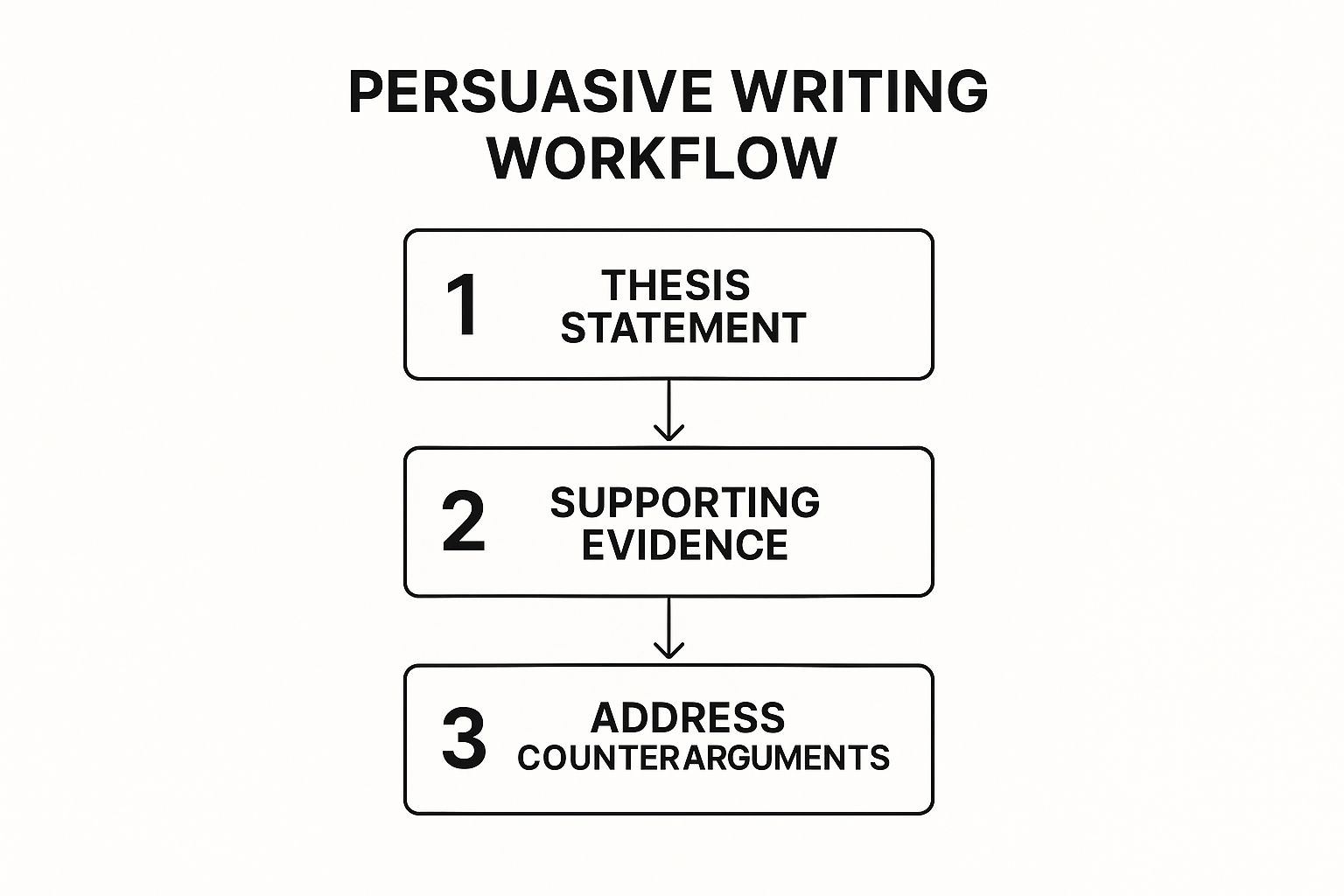
8 Writing Skills Examples to Elevate Your LinkedIn Content
Published on 2025-10-12
In the crowded world of professional networking, what separates a post that gets scrolled past from one that sparks conversation? It’s not just what you say, but how you say it. Strong writing is the foundation of a powerful LinkedIn presence, enabling you to build authority, connect with your audience, and achieve your professional goals. This guide moves beyond theory to provide concrete writing skills examples and strategic analysis tailored specifically for LinkedIn.
We will break down 8 essential skills, from storytelling and clarity to persuasion and editing. You will see exactly how these techniques are applied in successful posts to create content that stops the scroll and drives meaningful engagement. The goal is to give you a replicable framework for crafting posts that resonate, inform, and inspire your network.
To see these principles in action across different formats and draw inspiration for your own content, you can explore various diverse blog writing examples which often share the same foundational skills needed for LinkedIn. By mastering these core competencies, you'll be equipped to transform your professional profile into a dynamic platform for connection and opportunity.
1. Clear and Concise Writing
Clear and concise writing is the skill of expressing ideas directly and simply. It means removing unnecessary words, avoiding complex jargon, and getting straight to the point. This foundational skill ensures your message is not just seen, but understood quickly and effortlessly, which is crucial for capturing attention on a fast-scrolling platform like LinkedIn.

This approach respects your reader's time and makes your content more accessible. When you write clearly, you build trust and establish yourself as an authority who can distill complex topics into easy-to-digest insights. Among all the writing skills examples, this one is the most critical for professional communication.
Example in Action: Apple's Product Descriptions
Apple is a master of clear and concise writing. Instead of listing dense technical specifications, their copy focuses on user benefits in simple language.
- Before (Wordy & Technical): "Our new M4 chip integrates a 10-core CPU, a 10-core GPU, and a 16-core Neural Engine to facilitate machine learning acceleration, resulting in enhanced performance for a multitude of demanding computational tasks."
- After (Clear & Concise - Apple's Style): "The new M4 chip is outrageously fast. Fly through pro workflows, create stunning visuals, and play graphics-intensive games with all-day battery life."
This revision works because it translates technical features into tangible benefits ("fly through workflows") using active, powerful verbs.
How to Apply This to Your LinkedIn Posts
To make your posts more effective, focus on these actionable tips:
- Write First, Edit Later: Get your initial thoughts down without worrying about perfection. Then, go back and ruthlessly cut any word that doesn't add value.
- Use Simple Language: Swap complex words for simpler alternatives (e.g., use "use" instead of "utilize").
- Keep Sentences Short: Aim for an average sentence length of 15-20 words. This makes your writing easier to read on mobile devices.
- Read It Aloud: This helps you catch awkward phrasing and sentences that are too long. If you stumble while reading, your audience will too.
For more guidance on sharpening your professional communication, explore these business writing tips.
2. Storytelling and Narrative Structure
Storytelling is the art of weaving facts, emotions, and ideas into a compelling narrative that connects with readers on a human level. It involves using a clear structure with a beginning, middle, and end to transform a simple message into a memorable and impactful experience. This skill is vital for cutting through the noise on LinkedIn, as stories capture attention far more effectively than dry data.

A well-told story builds an emotional bridge between you and your audience, making your insights feel personal and relatable. Instead of just presenting information, you guide readers through a journey, making them more likely to remember your point and trust your perspective. Among the various writing skills examples, storytelling is what turns a forgettable post into a powerful conversation starter.
Example in Action: Humans of New York (HONY)
Humans of New York excels at using micro-stories to create profound emotional impact. Each post pairs a portrait with a short narrative from the subject's life, turning strangers into relatable characters.
- Before (Just Facts): "An 85-year-old woman in New York discusses her late husband. They were married for over 60 years and she has advice on maintaining a long-term relationship."
- After (Narrative - HONY's Style): "He had a list of things he wanted to do when he retired. But then he got sick. So I retired early and we did them all together. For his last birthday, I took him to see the Rockettes. He was so weak, but he told me, 'I'd go through all of this again, just to have you.'"
This storytelling approach works because it uses a specific, emotional anecdote to illustrate a universal theme of love and loss, making the message deeply resonant.
How to Apply This to Your LinkedIn Posts
Incorporate narrative elements into your professional content to make it more engaging:
- Start with a Hook: Open with a personal anecdote, a surprising moment, or a conflict you faced.
- Follow a Simple Arc: Structure your post with a clear setup (the problem), a confrontation (the struggle or action), and a resolution (the lesson learned).
- Show, Don't Tell: Instead of saying you learned a "valuable lesson," describe the specific event that taught you that lesson.
- Focus on One Core Message: Every story should have a point. Ensure your narrative directly supports the key takeaway you want your audience to remember.
To see how major brands use this technique, check out these business storytelling examples.
3. Grammar and Mechanics Proficiency
Grammar and mechanics proficiency is the skill of using correct punctuation, spelling, and sentence structure. It's the technical foundation that ensures your writing is professional, credible, and easy to read. Strong grammar eliminates distracting errors that can undermine your authority and make your message less impactful.
Mastering these rules makes your content polished and trustworthy. When your writing is clean and error-free, readers can focus entirely on your ideas, not on your mistakes. This is one of the most essential writing skills examples for building a professional reputation on platforms like LinkedIn.
Example in Action: The New York Times' Editorial Standards
The New York Times is a gold standard for grammatical precision. Their commitment to a consistent style guide ensures every article, from front-page news to opinion pieces, is clear, credible, and authoritative.
- Before (Error-Prone): "The companies ceo, Jane doe, said their profits were effected by supply chain issue's, its a major problem."
- After (Correct & Polished - NYT Style): "The company's CEO, Jane Doe, said its profits were affected by supply chain issues. 'It is a major problem,' she added."
The corrected version fixes multiple errors: the possessive "company's," the correct use of "its" versus "it's," the spelling of "affected," and the removal of the incorrect apostrophe in "issues." This precision builds reader trust.
How to Apply This to Your LinkedIn Posts
To ensure your posts are grammatically sound, integrate these habits:
- Use Grammar Tools: Leverage platforms like Grammarly or ProWritingAid to catch common errors before you publish.
- Proofread After a Break: Step away from your draft for at least 15 minutes. Fresh eyes are much better at spotting mistakes.
- Read It Aloud: Hearing your words can help you identify awkward phrasing and run-on sentences that spell-checkers might miss.
- Focus on Common Mistakes: Pay special attention to frequently confused words like their/there/they're, your/you're, and its/it's.
For a deeper dive into common errors, Mignon Fogarty’s Grammar Girl podcast is an excellent resource.
4. Research and Fact-Checking Skills
Research and fact-checking skills are about gathering, evaluating, and verifying information from credible sources to build authoritative content. This skill ensures your writing is accurate and trustworthy, which is essential for establishing expertise and credibility on a professional platform like LinkedIn. It involves distinguishing reliable data from misinformation and integrating facts seamlessly.
When you ground your arguments in solid evidence, you move from sharing opinions to providing real value. This skill is a powerful way to build an audience that trusts your insights and sees you as a go-to expert. Thorough research is one of the most respected writing skills examples you can demonstrate in a professional context.
Example in Action: The Washington Post's Fact Checker
The Washington Post's Fact Checker database is a prime example of rigorous verification. It systematically evaluates claims made by public figures, assigning a "Pinocchio" rating based on accuracy.
- Before (Unsupported Claim): "A politician claims, 'Our new policy created 5 million jobs last year,' without providing any data or source for this figure."
- After (Fact-Checked Statement): "The claim that the policy created 5 million jobs is inaccurate. According to Bureau of Labor Statistics data, job growth was 2.7 million for the year, and multiple economic factors contributed to this figure. We rate this claim Four Pinocchios."
This approach works because it replaces an empty assertion with a verifiable, data-backed conclusion, citing a credible authority (the Bureau of Labor Statistics) to build undeniable credibility.
How to Apply This to Your LinkedIn Posts
To strengthen your content with solid research, integrate these practices:
- Verify Before You Post: Always cross-reference key data points with at least two other reliable sources before publishing.
- Cite Your Sources: Link directly to the study, report, or article you're referencing. This transparency builds trust and allows readers to dig deeper.
- Use Reputable Databases: Rely on sources like Google Scholar, government statistics websites (e.g., BLS, Census Bureau), and established industry reports.
- Question Everything: Ask yourself if a source has a motive or bias. Is the data recent? Is the author an expert in that field?
For a deeper dive into source verification, learn more about the methodology used by leading organizations like the International Fact-Checking Network (IFCN).
5. Audience Awareness and Adaptation
Audience awareness is the skill of tailoring your writing style, tone, and content to meet the specific needs and expectations of your target readers. It means understanding who you're talking to, what they already know, and what they care about. This skill ensures your message resonates, rather than just being broadcast into the void.

On LinkedIn, where your audience can range from CEOs to junior hires, this skill is paramount. A post that lands perfectly with tech founders might completely miss the mark with marketing managers. Adapting your message is how you build a connection and demonstrate that you truly understand your audience's world, making it one of the most strategic writing skills examples to master.
Example in Action: WebMD vs. Medical Journals
The contrast between a medical journal and a WebMD article is a perfect demonstration of audience adaptation. A journal uses highly technical language for an expert audience, while WebMD translates that complexity into accessible advice for patients.
- Before (Technical & Journalistic): "The pathophysiological mechanisms of type 2 diabetes mellitus involve insulin resistance in peripheral tissues and a progressive decline in pancreatic β-cell function, leading to hyperglycemia."
- After (Adapted for a General Audience - WebMD Style): "With type 2 diabetes, your body either doesn't use insulin well or can't make enough to keep your blood sugar at normal levels. This can lead to high blood sugar, which can cause health problems over time."
This revision works because it swaps jargon ("pathophysiological mechanisms") for plain language ("how it works in your body") and focuses on the direct impact on the reader.
How to Apply This to Your LinkedIn Posts
To connect more effectively with your specific audience, try these tips:
- Create a Reader Persona: Before writing, define your ideal reader. What is their job title? What are their biggest professional challenges?
- Speak Their Language: Pay attention to the terms and phrases your audience uses in their own posts and comments. Use that vocabulary in your writing.
- Address "What's In It For Me?": Frame your insights around the direct benefits to your reader. Will your tip save them time, help them get promoted, or solve a common frustration?
- Vary Your Content: Adapt your examples and references to match your audience's industry and experience level.
Understanding your audience also involves knowing how to adapt your content across different mediums; for instance, explore strategies for transforming written articles into engaging audio for podcasts to reach broader audiences. To further refine your tone for different segments, you can discover more brand voice examples.
6. Persuasive and Argumentative Writing
Persuasive and argumentative writing is the skill of using logic, evidence, and emotional appeal to convince an audience to adopt your viewpoint or take a specific action. This goes beyond just stating facts; it involves building a compelling case that influences beliefs and behaviors. On LinkedIn, this skill is vital for thought leadership, sales, and driving engagement.
This infographic outlines the foundational workflow for building a strong argument, moving from a central claim to validation and defense.

Following this simple three-step process ensures your argument is structured, credible, and resilient to skepticism. Among the many writing skills examples, mastering persuasion can directly translate into achieving business objectives like generating leads or building brand loyalty.
Example in Action: Patagonia's Environmental Activism
Patagonia excels at persuasive writing by connecting its products to a greater cause. Their campaigns don't just sell jackets; they argue for environmental protection.
- Before (Generic & Sales-focused): "Our new jacket is made with 100% recycled materials and is built to last. Buy now to get a durable, high-quality product for your next adventure."
- After (Persuasive & Value-Driven - Patagonia's Style): "Don't Buy This Jacket. The environmental cost of everything we make is staggering. We ask you to buy less and to demand more from your products. Join us in reimagining a world where we take only what nature can replace."
This approach is powerful because it addresses a counterargument (consumerism) head-on, builds credibility through transparency, and appeals to the reader's values.
How to Apply This to Your LinkedIn Posts
To make your arguments more convincing, integrate these persuasive tactics:
- Start with Your Strongest Point: Capture attention immediately with your most compelling piece of evidence or your main claim.
- Use the AIDA Model: Structure your post to grab Attention, build Interest, create Desire for your idea, and call for Action.
- Support Claims with Evidence: Back up your statements with data, statistics, expert quotes, or relevant case studies to build credibility.
- Acknowledge Counterarguments: Briefly address potential objections to your point. This shows you've considered different perspectives and strengthens your position.
7. Editing and Revision Mastery
Editing and revision mastery is the skill of refining a draft until it is polished, powerful, and error-free. It's the disciplined process of reviewing your work to improve its structure, clarity, and impact. This skill separates good writers from great ones, as it involves stepping back from your creation to see it through the eyes of your audience.
This skill is about recognizing that the first draft is just the starting point. Mastering revision ensures your final message is as strong and persuasive as possible. Among the many writing skills examples you can develop, this one guarantees a higher level of quality and professionalism in your work.
Example in Action: Stephen King's "Cut 10%" Rule
In his book On Writing, Stephen King advocates for a ruthless revision process, famously advising writers that "the second draft = the first draft - 10%." This isn't about arbitrary cuts but about removing everything that doesn't serve the story or message.
- Before (Wordy First Draft): "In order to make your LinkedIn posts truly effective and much more engaging for your audience, you absolutely must make a conscious effort to remove any and all of the words that are not completely essential to the core message you are trying to convey."
- After (Revised with King's Rule): "To make your LinkedIn posts more engaging, remove every word that isn't essential to your core message."
This revision works because it is direct and powerful. It eliminates filler phrases ("in order to," "truly effective," "conscious effort") and tightens the sentence structure, making the advice more memorable and impactful.
How to Apply This to Your LinkedIn Posts
To elevate your editing process, integrate these professional habits:
- Take a Break: Step away from your draft for at least a few hours, or ideally 24. A fresh perspective helps you spot errors and weaknesses you previously missed.
- Edit in Passes: Review your post multiple times, each time focusing on a different element: first for structure and flow, then for clarity, and finally for grammar and spelling.
- Read It Aloud: This technique is the fastest way to identify awkward phrasing, clunky sentences, and poor rhythm. If it sounds wrong, it reads wrong.
- "Kill Your Darlings": Be willing to delete your favorite sentences or phrases if they don't contribute directly to your main point. Brevity is a strength on LinkedIn.
8. SEO and Digital Writing Optimization
SEO and digital writing optimization is the skill of creating content that satisfies both search engines and human readers. It involves crafting valuable, readable articles that are strategically structured to rank high in search results for specific keywords. This skill blends creative writing with a technical understanding of how platforms like Google evaluate and prioritize content.
This dual focus is essential for driving organic traffic and establishing long-term authority. By mastering SEO, you ensure your expertise reaches the widest possible audience, positioning yourself as a go-to resource. Among the many writing skills examples, this one is crucial for sustainable content marketing success.
Example in Action: Backlinko's Content Guides
Backlinko, founded by Brian Dean, is a masterclass in SEO writing. Their guides are famous for ranking at the top for highly competitive marketing terms because they are incredibly thorough and optimized for user intent.
- Before (Standard Blog Post): "A short blog post titled 'Quick Tips for Link Building' might list a few common strategies without much detail, leaving the reader with more questions than answers."
- After (Optimized & Comprehensive - Backlinko's Style): "A 5,000-word definitive guide titled 'Link Building for SEO: The Definitive Guide' that covers every conceivable aspect, includes original data, step-by-step tutorials, and dozens of examples."
This approach works because it fully satisfies the searcher's query, signaling to Google that it's the most valuable resource on the topic.
How to Apply This to Your LinkedIn Articles
While LinkedIn isn't a traditional search engine, its internal search and Google indexing make SEO principles valuable for discoverability.
- Research Keywords: Use tools like Google Keyword Planner to find terms your audience is searching for related to your industry.
- Focus on Search Intent: Understand what a person wants when they search for a keyword. Are they looking for a definition, a tutorial, or a comparison?
- Write Comprehensive Content: For LinkedIn Articles, create in-depth pieces that comprehensively cover a topic, just like you would for a blog.
- Use Keywords Naturally: Place your primary keyword in your article title, the first paragraph, and a few subheadings. Avoid unnatural stuffing.
For a deeper dive into content that ranks, explore the strategies on the Backlinko blog.
Writing Skills: 8 Key Competencies Compared
| Skill/Aspect | Implementation Complexity 🔄 | Resource Requirements ⚡ | Expected Outcomes 📊 | Ideal Use Cases 💡 | Key Advantages ⭐ |
|---|---|---|---|---|---|
| Clear and Concise Writing | Moderate; requires editing and refinement | Low to moderate; time for rewriting and review | High clarity, reader comprehension, and engagement | Business communications, technical docs, marketing | Improves comprehension, reduces ambiguity, saves time |
| Storytelling and Narrative Structure | High; demands creativity and narrative skill | Moderate to high; time for crafting and revising story | Emotional engagement, memorability, and brand loyalty | Marketing campaigns, presentations, non-fiction | Builds emotional connection, enhances persuasion |
| Grammar and Mechanics Proficiency | Moderate; learning rules and consistent application | Low to moderate; use of tools and style guides | Professional, credible, and error-free writing | Publishing, journalism, academic and formal writing | Establishes credibility, prevents miscommunication |
| Research and Fact-Checking Skills | High; thorough evaluation and verification required | Moderate to high; access to credible sources and tools | Trustworthy, authoritative content with validated facts | Investigative journalism, academic writing, reports | Builds trust, prevents misinformation, supports arguments |
| Audience Awareness and Adaptation | Moderate; requires upfront audience research and tailoring | Moderate; time for personas and testing | Higher engagement, relevance, and comprehension | Marketing, technical writing, educational content | Increases relevance, reduces miscommunication, shows empathy |
| Persuasive and Argumentative Writing | High; involves strategic logic, evidence, and rhetoric | Moderate to high; research and preparation needed | Influential content driving action and opinion change | Marketing, sales, leadership communications | Effective influence, drives conversions, strong argumentation |
| Editing and Revision Mastery | High; multiple detailed passes needed | Moderate; time and possibly external feedback | Polished, clear, error-free, and well-structured writing | All writing types, especially publication and professional | Significantly improves quality, catches errors, clarifies |
| SEO and Digital Writing Optimization | Moderate to high; combines writing with technical SEO | Moderate to high; keyword research and analytics tools | Increased organic traffic and search visibility | Web content, blogs, e-commerce, digital marketing | Boosts visibility, sustainable traffic, improves UX |
Putting It All Together: Your Blueprint for High-Impact LinkedIn Writing
We've explored a comprehensive set of writing skills examples, from the foundational power of clarity and conciseness to the strategic nuance of persuasive storytelling. Each skill, whether it's meticulous research or masterful editing, acts as a crucial tool in your content creation arsenal. But knowing the tools is only half the battle; the real transformation happens when you start using them consistently.
The journey to becoming an influential voice on LinkedIn isn't about achieving overnight perfection. It's about a commitment to continuous improvement and intentional practice. The examples we've analyzed demonstrate that powerful writing is a product of deliberate choices, not accidental genius. It's about understanding your audience, structuring a compelling narrative, and polishing every sentence until it serves a clear purpose.
From Theory to Practice: Your Actionable Roadmap
To avoid feeling overwhelmed, focus on incremental progress. Don't try to master all eight skills at once. Instead, adopt a focused, one-skill-per-week approach to build lasting habits.
Here is a simple blueprint to get you started:
- Week 1: Focus on Clarity. Take one of your existing posts and challenge yourself to cut 25% of the word count without losing the core message. Remove jargon, simplify complex sentences, and get straight to the point.
- Week 2: Weave in a Story. Instead of just stating a business outcome, frame it as a short story. Use a simple structure: introduce a problem, describe the action you took, and reveal the resolution or lesson learned.
- Week 3: Conduct a Grammar Audit. Use a grammar-checking tool to review your last five posts. Identify your most common mistakes and make a conscious effort to avoid them in your next draft.
- Week 4: Deepen Audience Awareness. Before you write, create a mini-profile of your ideal reader. What are their biggest challenges? What solutions are they seeking? Write your post directly to that person.
By isolating and practicing each skill, you integrate it into your natural workflow. Soon, what once required intense focus will become second nature, elevating the quality and impact of everything you publish.
The True Value of Exceptional Writing Skills
Mastering these writing skills is about more than just getting more likes or comments. It's about building trust, establishing authority, and creating genuine connections. When your writing is clear, insightful, and authentic, you earn the attention of your audience. You become a go-to resource in your industry, opening doors to new opportunities, partnerships, and career growth.
Your LinkedIn profile is your digital storefront, and your content is your most powerful marketing tool. Every post is an opportunity to showcase your expertise, share your values, and build your professional brand. By investing in your writing, you are investing directly in your professional future. Start today, one word at a time, and watch your influence grow.
Ready to apply these principles with greater speed and consistency? The autoghostwriter platform helps you generate high-quality LinkedIn post ideas and drafts based on these exact writing skills examples. Leverage AI-powered templates to perfect your storytelling, clarity, and persuasive arguments in minutes, not hours. Start writing with purpose today.